Do you have a budding young scientist in your family who is curious about the natural world? Volcanoes are an exciting and powerful force of nature that have captured the imaginations of people for centuries. Here are some fun facts about volcanoes that will spark their interest and help them learn more about these fascinating geological features.
What is a Volcano?
Volcanoes are openings in the Earth’s crust where molten rock, ash, and gases escape from deep below the surface. They can be found on land or underwater and can vary in size from small cinder cones to massive shield volcanoes.
Types of Volcanoes
There are different types of volcanoes, including shield volcanoes, stratovolcanoes, and cinder cone volcanoes. Each type has its own unique shape and eruptive behavior.
Famous Volcanoes
Some of the most famous volcanoes in the world include Mount Vesuvius in Italy, which famously erupted in 79 AD and buried the city of Pompeii, as well as Mount St. Helens in the United States, which erupted in 1980 and caused widespread destruction.
Eruption Types
Volcanic eruptions can be explosive or effusive. Explosive eruptions release a large amount of ash and rock fragments, while effusive eruptions release lava flows that can flow for long distances.
Ring of Fire
The Ring of Fire is a horseshoe-shaped area in the Pacific Ocean where many volcanoes are located. This region is known for its high level of volcanic activity and earthquakes.
Volcanic Hazards
Volcanic eruptions can pose risks to both people and the environment. These hazards can include lava flows, ash clouds, pyroclastic flows, and lahars (mudflow). It is important to be prepared and know what to do in case of a volcanic eruption.
Volcano Hotspots
Volcanic hotspots are areas where volcanic activity is concentrated, usually due to a plume of hot magma rising from the Earth’s mantle. Examples of volcanic hotspots include Hawaii and Yellowstone National Park.
Volcanic Rocks
When molten lava cools and solidifies, it forms different types of volcanic rocks. Some common types of volcanic rocks include pumice, obsidian, and basalt.
Monitoring Volcanoes
Scientists use a variety of techniques to monitor volcanic activity and predict eruptions. These methods include seismometers, gas sensors, and satellite observations.
Learning about volcanoes can be a fun and educational experience for kids of all ages. By exploring the world of volcanoes, children can gain a better understanding of Earth’s dynamic geology and the power of nature. Who knows, maybe your child will be inspired to become a volcanologist and study these incredible natural wonders for a living.

